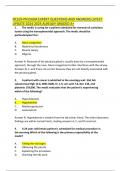NCLEX-PN EXAM EXPERT QUESTIONS AND ANSWERS LATEST
UPDATE 2024-2025 ALREADY GRADED A+
1. The medic is caring for a patient scheduled for removal of a pituitary
tumor using the transsphenoidal approach. The medic should be
particularlyalert for:
A. Nasal congestion
B. Abdominal tenderness
C. Muscle tetany
D. Oliguria
Answer A: Removal of the pituitary gland is usually done by a transsphenoidal
approach, through the nose. Nasal congestion further interferes with the airway.
Answers B, C, and D are not correct because they are not directly associated with
the pituitary gland.
2. A patient with cancer is admitted to the oncology unit. Stat lab
valuesreveal Hgb 12.6, WBC 6500, K+ 1.9, uric acid 7.0, Na+ 136, and
platelets 178,000. The medic evaluates that the patient is experiencing
which of the following?
A. Hypernatremia
B. Hypokalemia
C. Myelosuppression
D. Leukocytosis
Answer B: Hypokalemia is evident from the lab values listed. The other laboratory
findings are within normal limits, making answers A, C, and D incorrect.
3. A 24-year-old female patient is scheduled for medical procedure in
the morning.Which of the following is the primary responsibility of the
medic?
A. Taking the vital signs
B. Obtaining the permit
C. Explaining the procedure
D. Checking the lab work
,Answer A: The primary responsibility of the medic is to take the vital signs before
any medical procedure. The actions in answers B, C, and D are the responsibility
of the doctor and, therefore, are incorrect for this question.
4. The medic is working in the emergency room when a patient arrives
withsevere burns of the left arm, hands, face, and neck. Which action should
receive priority?
A. Starting an IV
B. Applying oxygen
C. Obtaining blood gases
D. Medicating the patient for pain
Answer B: The patient with burns to the neck needs airway assessment and
supplemental oxygen, so applying oxygen is the priority. The next action should
be to start an IV and medicate for pain, making answers A and C incorrect.
Answer D, obtaining blood gases, is ordered by the doctor.
5. The medic is visiting a home health patient with osteoporosis. The
patient has a new prescription for alendronate (Fosamax). Which instruction
should begiven to the patient?
A. Rest in bed after taking the drug for at least 30 minutes
B. Avoid rapid movements after taking the drug
C. Take the drug with water only
D. Allow at least 1 hour between taking the medicine and taking
other drugs
Answer B: The patient with burns to the neck needs airway assessment and
supplemental oxygen, so applying oxygen is the priority. The next action should
be to start an IV and medicate for pain, making answers A and C incorrect.
Answer D, obtaining blood gases, is ordered by the doctor.
,6. The medic is making initial rounds on a patient with a C5 fracture
and crutchfield tongs. Which equipment should be kept at the bedside?
A. A pair of forceps
B. A torque
wrench
C. A pair of wire cutters
D. A screwdriver
Answer B: A torque wrench is kept at the bedside to tighten and loosen the
screws of crutchfield tongs. This wrench controls the amount of pressure that is
placed on the screws. A pair of forceps, wire cutters, and a screwdriver, in
answers A, C, and D, would not be used and, thus, are incorrect.
7. An newborn weighs 7 pounds at birth. The expected weight by 1
yearshould be:
A. 10 pounds
B. 12 pounds
C. 18 pounds
D. 21
pounds
Answer D: A birth weight of 7 pounds would indicate 21 pounds in 1 year, or triple
his birth weight. Answers A, B, and C therefore are incorrect.
8. A patient is admitted with a Ewing’s sarcoma. Which symptoms
wouldbe expected due to this tumor’s location?
A. Hemiplegia
B. Aphasia
C. Nausea
D. Bone pain
Answer D: Sarcoma is a type of bone cancer; therefore, bone pain would be
expected. Answers A, B, and C are not specific to this type of cancer and are
incorrect.
, 9. The medic is caring for a patient with epilepsy who is being treated
withcarbamazepine (Tegretol). Which laboratory value might indicate a
serious side effect of this drug?
A. Uric acid of 5mg/dL
B. Hematocrit of 33%
C. WBC 2,000 per cubic millimeter
D. Platelets 150,000 per cubic millimeter
Answer C: Tegretol can suppress the bone marrow and decrease the white blood
cell count; thus, a lab value of WBC 2,000 per cubic millimeter indicates side
effects of the drug. Answers A and D are within normal limits, and answer B is a
lower limit of normal; therefore, answers A, B, and D are incorrect.
10. A 6-month-old patient is admitted with possible intussuception.
Which question during the nursing history is least helpful in obtaining
information regarding this diagnosis?
A. “Tell me about his pain.”
B. “What does his vomit look
like?” C. “Describe his usual diet.”
D. “Have you noticed changes in his abdominal size?”
Answer C: The least-helpful questions are those describing his usual diet. A, B,
and D are useful in determining the extent of disease process and, thus, are
incorrect.
11. The medic is assisting a patient with diverticulosis to select
appropriate foods. Which food should be avoided?
A. Bran
B. Fresh peaches
C. Cucumber
salad
D. Yeast rolls





